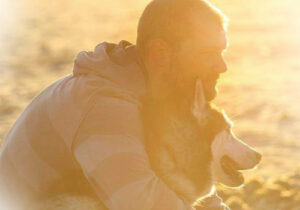How to say goodbye to your pet
Saying good bye to your beloved pet is one of the hardest things you will ever have to do in your life. Unfortunately our pets don’t live as long as we do, although I’m sure we all agree that we wish they did. However, as I always say to my clients, giving your pet a painless, stress free death is the final kindness we can give them.
No owner comes to this decision lightly, but once you have made the decision there are a few things that you can do to make the time together before then as memorable as possible. As a pet owner and a vet, these are a few of the things my husband and I did for our beloved Siberian Husky Freya before we had her put to sleep.
Some of my suggestions are:
- Make their last few days amazing and memorable – give them their favourite foods, take them on their favourite walk, play with their favourite toy, scratch them in their favourite spot
- Plan the euthanasia day – we had Freya put to sleep at home which allowed her to be stress free. Speak to your vet about this service
- Plan their burial or cremation – we opted for cremation so that no matter where we live, Freya will always be with us
- Reflect upon their life – look through photos and videos and remember them when they were younger
- Surround yourself with supportive people
- Speak to someone qualified in pet bereavement counselling
- Be present and enjoy the time you have left with your beloved pet
How do I know when it is the right time?
There are many reasons pet owners will end up asking this question. As a vet, for me the number 1 thing to consider is – does your pet still have good quality of life? But, how do you know if their quality of life is good or bad? Well, there are a few indicators I use to help owners with their decision making:
- Is your pet able to eat and drink normally, and enjoying eating
- Can they go to the toilet normally or are they having lots of accidents or have become incontinent
- Do they still have interest in the things they used to such as going for a walk, enjoying watching birds out of the window, playing with toys
- Is your pet in pain, or has their previously controlled pain become uncontrolled
You know your pet better than anyone else, and so quite often you will already know that the decision has been made by you and your pet. If you are still unsure, speak to your vet. They will help give you advice and may suggest examining your pet and then re-examining at a set time point.
Unfortunately it is quite uncommon for pets to just go to sleep and pass away, and therefore you play a very important role in being their guardian and protecting them from any suffering. Someone once said to me that they felt priveliged to be able to take their pet all the way through a happy life and got to be with them at the end. I thought this was a great way of dealing with such a difficult decision, and quite often relay that story to my clients when we are discussing the end of their pet’s life.
As a vet, I have euthanased a lot of animals, and every time I perform the procedure I make sure I talk the owner through what exactly is going to happen. So let me explain a bit about the process so that you are more prepared.
Euthanasia
Euthanasia literally means a gentle and easy death. That is what we want for you and your pet. When making the appointment, make it clear to the veterinary receptionist about the intention of the appointment. This allows them to book a larger appointment slot for you and your pet. If you can have a supportive partner or friend with you it will help. We don’t always know how we will react under theses emotional circumstances, so it is good to have someone with you at this difficult time.
Once you are taken into the consulting room, you will be asked to sign a consent form. This is a vital piece of paperwork that gives the vet permission to euthanase your pet. Euthanasia in pets is usually performed by an injection which administers an overdose of anaesthetic. The vet will usually have a nurse assist them in performing the injection. But don’t worry, you can be there for the whole procedure, by your pets side. They will normally clip a small area of hair off on a front leg where the injection will be given. Some vets like to sedate pets prior to the injection, especially if they are more agitated.
When the injection is given, it is given slowly into the vein. The injection itself is like a little sharp scratch, and then the fluid is administered. The whole process is completely pain free for your pet. Occasionally once the injection starts taking effect, some pets may make a noise. This is just a side effect of the anaesthetic taking effect and not a sign of any pain at all. Within a few seconds your pet will lose consciousness and the vet will check their heart with their stethoscope. We usually like to listen to the heart a few times especially if your pet has been extremely ill. It can take longer for the drugs to stop heart in very ill pets.
I always advise owners that after the euthanasia injection has been administered, it is possible that your pet may make involuntary muscle movements and may gasp. This is completely normal and are not conscious movements. They are caused by reflexes from the brain and are a sign that death has occurred. Most often your pet’s eyes will stay open. Please do not worry about this, as closing the eyes is an active process and therefore does not happen after death.
What happens next?
This all depends on what you have planned for your pet’s body. Your vet may provide you with information on crematoria that they use for communal or private cremations, but you may also want to research crematoria for yourself (I have added some links below). You may want to take your pet home and bury them in your garden. These are very personal choices, and no one choice is right or wrong. You must do what you feel comfortable with.
Memories of your pet
Some people like to take locks of hair for safe keeping, others like to plant a tree over the burial site of their pet. My husband and I chose to have a private cremation of Freya and had her ashes returned in a beautiful urn. We will always have her with us, and that gives us comfort. Some clients also like to use the ashes to have jewellery made in their pet’s memory; and some like to have pawprints taken of their pet to place in a frame.
Please remember, you are never alone. If you are finding it difficult to cope with the death of your pet, there are many organisations out there that provide support for pet bereavement. Speak to friends, colleagues and loved ones. And remember, always remember your pet. Remember all the good times you had together, and without them you would not have those memories.
Grief is the price we pay for love. For me it is a price that I am willing to pay to have spent so many wonderful years with our beloved Freya x

Useful links are :





